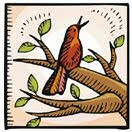Bad choices for areas near paving or sidewalks
 Due to their large roots at the surface of the soil, these trees are not suitable for planting near sidewalks or driveways. They will cause problems if planted within "wells" in paved areas, parking lots, etc., and they will be increasingly difficult to mow around, wherever they are planted. Be careful that you don't plant them where their roots will be a trial and tribulation in your life.
Due to their large roots at the surface of the soil, these trees are not suitable for planting near sidewalks or driveways. They will cause problems if planted within "wells" in paved areas, parking lots, etc., and they will be increasingly difficult to mow around, wherever they are planted. Be careful that you don't plant them where their roots will be a trial and tribulation in your life.Red maple (Acer rubrum)
Silver maple (Acer saccharinum)
River birch (Betula nigra)
Hackberries (Celtis spp.)
Beech (Fagus grandifolia)
Sweetgum (Liquidambar styraciflua)
Southern magnolia (Magnolia grandiflora)*
American sycamore (Platanus occidentalis)
Pin oak (Quercus palustris)
Willow oak (Quercus phellos)
Live oak (Quercus virginiana)
American elm (Ulmus americana)
From a list in Trees for Paved Areas, a 2002 publication of the Virginia Cooperative Extension. Non-native trees in the list include weeping willow, London planetree, and Norway maple.
*Your nursery may recommend cultivars of the southern magnolia that are supposed to have fewer surface roots. It would be a good idea to do some thorough research of the cultivar on your own, before planting .

 "The power to recognize trees at a glance without examining their leaves or flowers or fruit as they are seen, for example, from the car-window during a railroad journey, can only be acquired by studying them as they grow under all possible conditions over wide areas of territory. Such an attainment may not have much practical value, but once acquired it gives to the possessor a good deal of pleasure which is denied to less fortunate travelers."
"The power to recognize trees at a glance without examining their leaves or flowers or fruit as they are seen, for example, from the car-window during a railroad journey, can only be acquired by studying them as they grow under all possible conditions over wide areas of territory. Such an attainment may not have much practical value, but once acquired it gives to the possessor a good deal of pleasure which is denied to less fortunate travelers."
0 comments -- please add yours:
Post a Comment